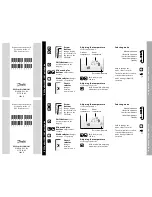
7
vacon • 72
Modbus TCP / Modbus UDP
Local contacts: https://www.danfoss.com/en/contact-us/contacts-list/
7.
M
ODBUS
TCP / M
ODBUS
UDP
Modbus is a communication protocol developed by Modicon systems. In simple terms, it is a way of
sending information between electronic devices. The device requesting the information is called the
Modbus Master (or the Client in Modbus TCP/UDP) and the devices supplying information are
Modbus Slaves (in Modbus TCP/UDP servers). In a standard Modbus network, there is one Master
and up to 247 Slaves, each with a unique Slave Address from 1 to 247. The Master can also write
information to the Slaves. Modbus is typically used to transmit signals from instrumentation and
control devices back to the main controller or data gathering system.
The Modbus communication interface is built around messages. The format of these Modbus
messages is independent of the type of physical interface used. The same protocol can be used
regardless of the connection type. Because of this, Modbus gives the possibility to easily upgrade
the hardware structure of an industrial network, without the need for large changes in the software.
A device can also communicate with several Modbus nodes at once, even if they are connected with
different interface types, without the need to use a different protocol for every connection.
Figure 33. Basic structure of Modbus frame
On simple interfaces like RS485, the Modbus messages are sent in plain form over the network. In
this case, the network is dedicated to Modbus. When using more versatile network systems like
TCP/IP over Ethernet, the Modbus messages are embedded in packets with the format necessary
for the physical interface. In that case Modbus and other types of connections can co-exist at the
same physical interface at the same time. Although the main Modbus message structure is peer-
to-peer, Modbus is able to function on both point-to-point and multidrop networks.
Each Modbus message has the same structure. Four basic elements are present in each message.
The sequence of these elements is the same for all messages, to make it easy to parse the content
of the Modbus message. A conversation is always started by a master in the Modbus network. A
Modbus master sends a message and depending of the contents of the message a slave takes action
and responds to it. There can be more than one master in a Modbus network. Addressing in the
message header is used to define which device should respond to a message. All other nodes on the
Modbus network ignore the message if the address field does not match their own address.
If you need to contact VACON
®
service in problems related to Modbus TCP/UDP, send a description
of the problem together with the Drive Info File to the local distributor. See local contacts:
www.danfoss.com
. If possible, also send a "Wireshark" log from the situation if applicable.
11608_uk
Master´s
message
Slave
response
Start
Address
Function
Data
CRC
End
Start
Address
Function
Data
CRC
End
Summary of Contents for optea
Page 2: ......
















































